A bike for people who aren't interested in cycling
The title of this post might sound a little bit odd - who would ride a bike, when they're not excited or interested by them? The short answer is 'the Dutch', who cycle around every day of the week in their millions on sturdy, reliable bikes that the vast majority of them will know absolutely nothing about.
They won't know how to fix punctures, what gear ratio they are using, what their bike weighs, how fast they're going, or how the lighting system works. For them, bikes are just a tool to get them from A to B, and definitely not a hobby. They will step onto it in much the way as we will slip on a pair of shoes, and set off with about as much thought for it as we have for what's on our feet. Paradoxically, the country that cycles the most is just as uninterested in the ins and outs of bikes as us non-cycling Britons.
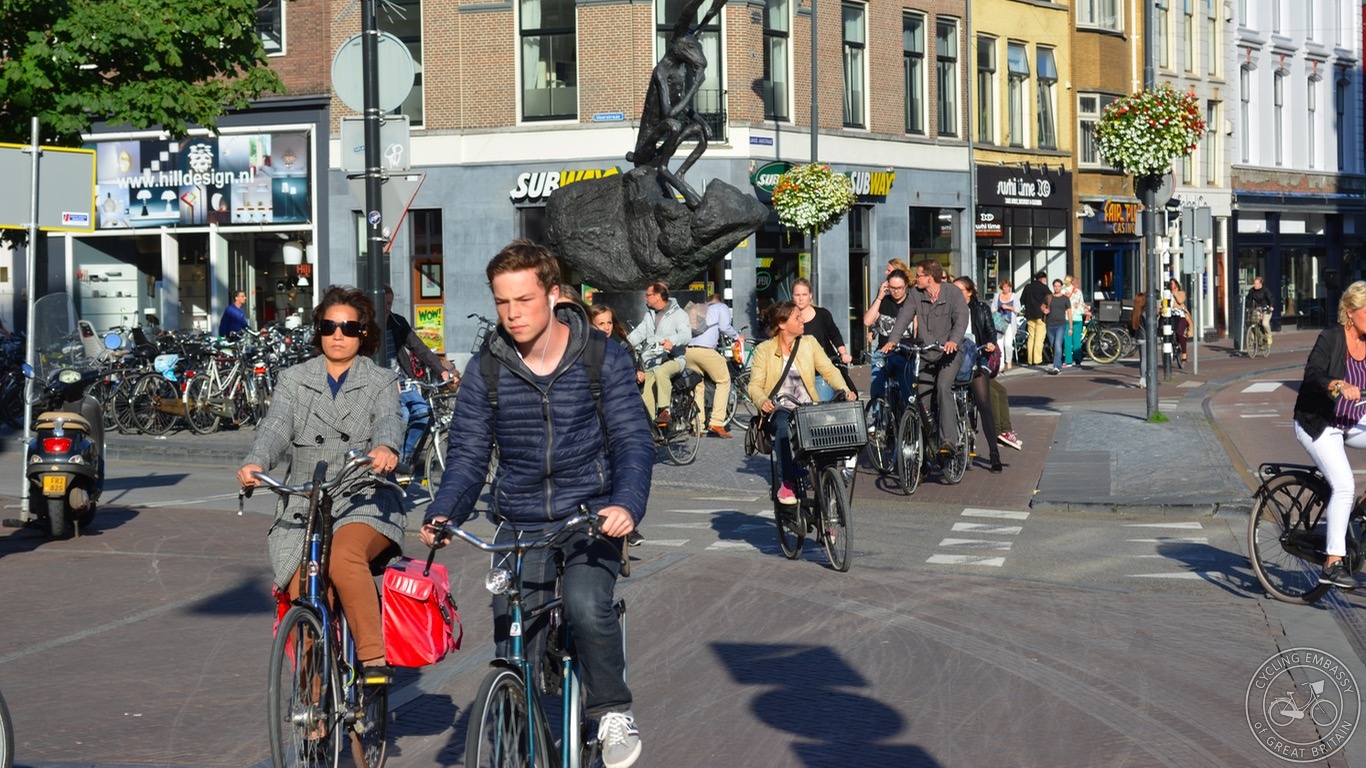
Crucially, the Dutch don't need to be interested. Their bikes are designed to be convenient, ride-and-forget machines that require little or no maintenance, no optional extras, and no faffing around at the start and end of a journey. They are used in much the same way that cars are used by people who don't really care about cars.
So what are the essential elements of the machines that the Dutch use every day?
Enclosed chain and gears
The 'technical stuff' - the chain and gears on the bike - are not exposed to the elements at all. The chain is covered completely by a case, which means that it doesn't get any dirt or rain on it. That means it works all year round, with no need for any cleaning or maintenance, bar an occasional drop of oil every few months or so, when I notice any squeaking. That's it.
The gears are also all fully enclosed, within the rear hub. I've never had to do any servicing here either, in seven years. I ride this bike pretty much every day, in all weathers, and it has stood the test of time remarkably. We don't expect people to do frequent maintenance on the transmission of their cars - why should bikes be any different?
Mudguards
You can't stop the rain from falling from the sky, but you certainly can stop the rain that is falling on the ground from being sprayed back onto you, combined with all the dirt and filth that is on the road. My omafiets has large, robust mudguards that prevent any of that stuff from being flung up onto me and my clothes. This especially applies in winter, when roads and paths can still be wet and mucky when it's not even raining.
Built-in lighting
This is a big one. Just as we don't expect drivers to charge their headlights, or take them with them when they park their cars, my lights are part of the bike, not an optional extra that I have to remove and attach every time I cycle anywhere. I don't have to charge them either - they're powered by a dynamo in the front hub, which means they turn on as soon as I start to ride. A capacitor also means they stay on for around five minutes, any time I'm stationary.
Luggage capacity
Despite being a standard omafiets - and not a cargobike specifically designed for carrying extra passengers, or heavier items - my bike can handle most day-to-day loads. I do have to suppress a slight chuckle when people assume bikes can't even carry shopping, because almost every day I carry the weight of another adult human being on the back, something that is ubiquitous in the Netherlands.

I wince when I think about how I used to do all my shopping by strapping an enormous rucksack onto my back, because my bikes didn't have with any luggage carrying capacity. Now, I just pop my shopping in the front crate, or on the adaptable rear rack. I either use large durable panniers, which come with fitted bags for carrying items to and from the bike, or I just rely on the top surface of the rack itself, and the sturdy rubber straps called 'snelbinders' to hold items down.
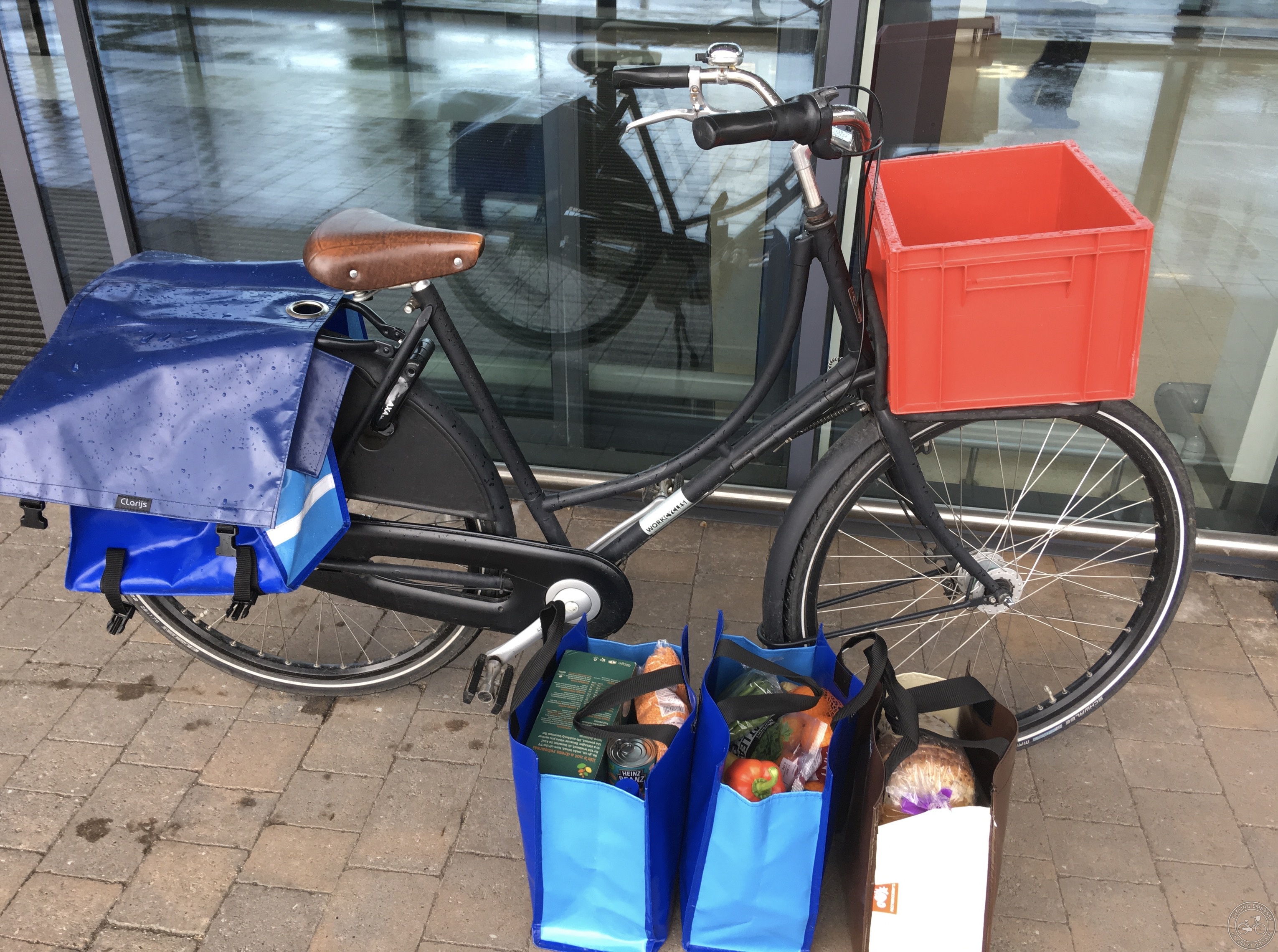
Kickstand
Simple, but essential - it means I can park my bike anywhere, and I don't have to find something to lean it against. As a left-handed (and left-footed) person, I really appreciate the excellent twin-foot stand the bike came with, which is really stable, and also means I can mount and dismount from either side.
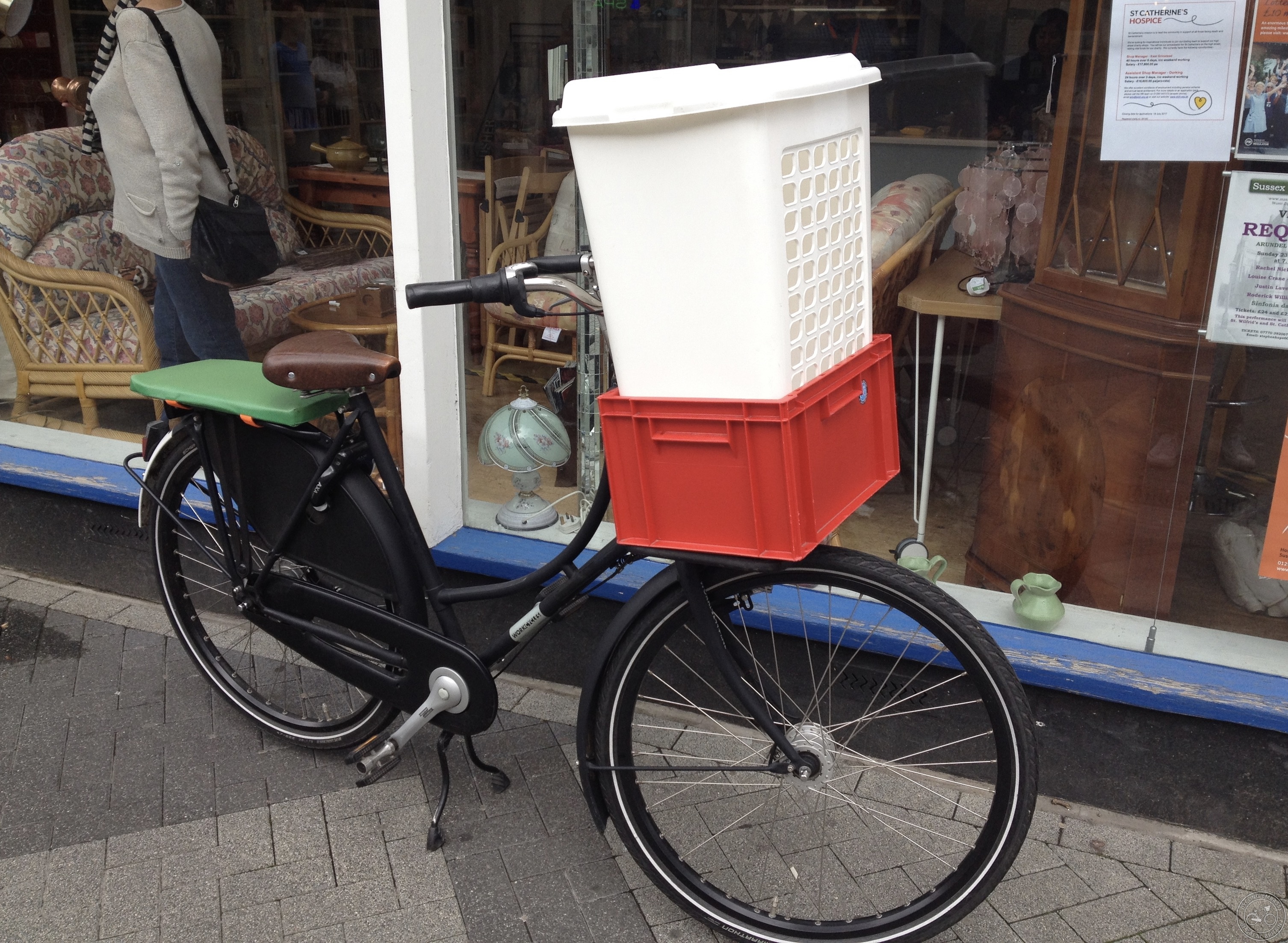
Wheel lock
This works almost like the ignition of a car - the bike won't move unless the key is in the lock. A sturdy steel bar passes through the rear spokes, preventing the wheel from turning unless the key releases it. Combined with the kickstand, this makes shopping or short visits extremely easy - the bike can be parked up directly outside my destination, and removing the key means it is immobilised. link to my video The weight of the bike means it can't really be stolen unless the thief has a van to load it into, and if they try to ride it away, they may get... a nasty surprise.
My cycling photo of the year has to be this absolute balloon trying to steal my cargobike and getting all of 0.05m being pure wrecked pic.twitter.com/eLtwtYs1Ms
— Ellen Murray #WellFundedTransLobby (@ellenfromnowon) December 9, 2016
This is in fact how most Dutch people leave their bikes on a daily basis, either at train stations, or in city centres - not actually locked to anything. British cyclists might be sniffy about the impracticality of the front-wheel-holding bike rack (the so-called 'wheelbender') which leaves them with nothing to lock to, but they make sense for a mass cycling public who rely on the internal lock of their bike.
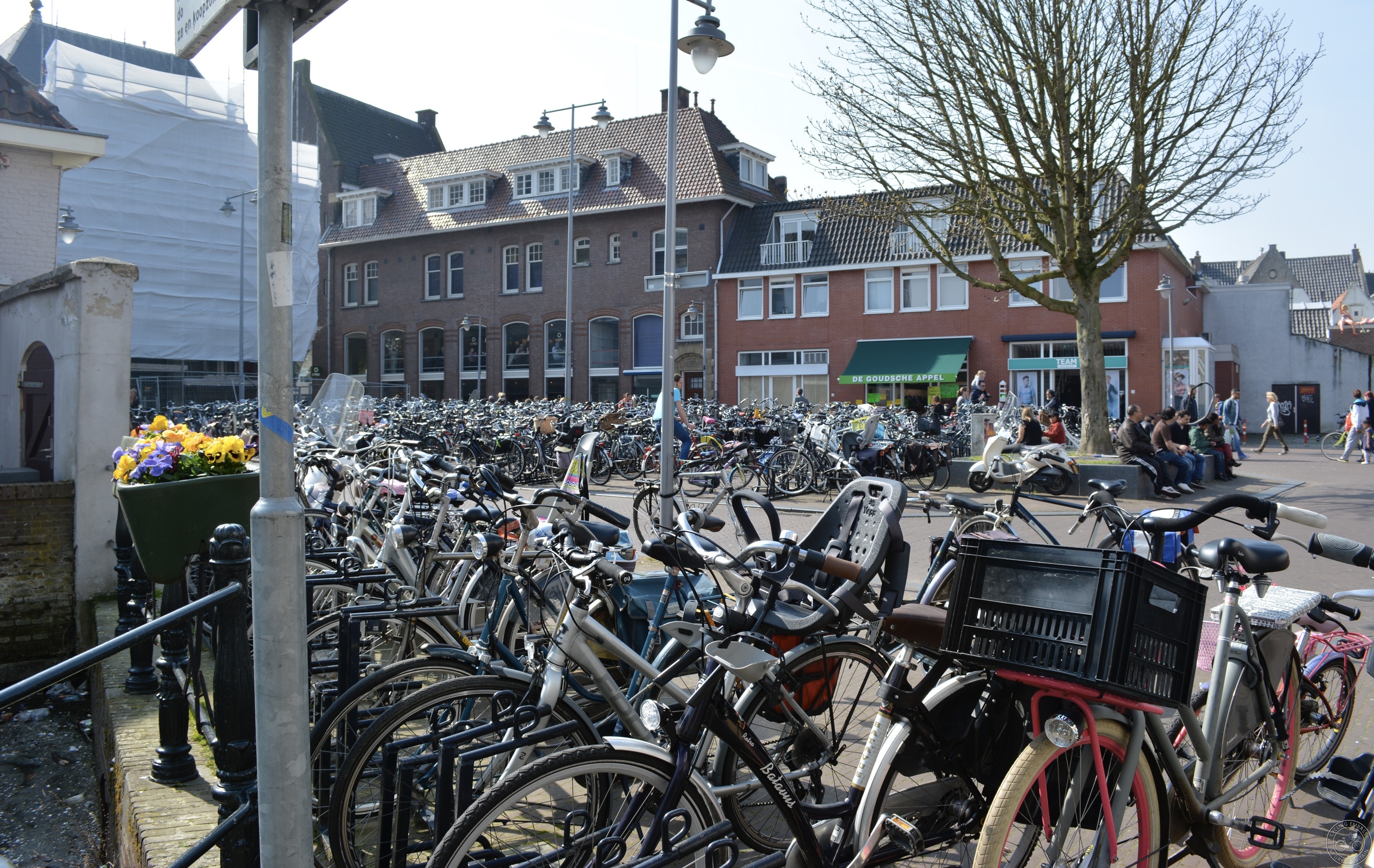
Brakes
Just like the chain and gears, the brakes are hidden away from the elements, built into the hubs of the bike - that also means dirt from the brakes doesn't get on me. The rear brake is a back-pedal 'coaster' type, which took a little bit of getting used to, but which I now absolutely love, because it leaves my hands free for practical things like signalling when I'm braking, and carrying an umbrella when it's raining.
Upright position
Finally, I think it's important to emphasise the big difference the riding position of the bike makes. Being used to cycling around on bikes that left me hunched forwards, it was a revelation to be riding upright, engaging with the world around me at the same familiar angle as I would be if I were walking. The weight is taken off my hands, leaving them free for trivial things like waving hello, or gesturing to let people cross the road in front of me. It just feels... friendlier. The experience is almost like an enhanced form of walking, which I think is persuasive when it comes to arguments against the need for 'safety equipment' (in other words, helmets). It's also a step-through frame, the type of design which is still often marketed (wrongly) as a 'woman's bike', despite the obvious convenience in dismounting and mounting it offers to both men and women.
And that's it - the essential ingredients of a machine that powers a nation, and one that could power ours too. Cycling doesn't need to be difficult or impractical. We just need the right bikes to ride on - and there's a wide range of cycles beyond this traditional staple, that enable an enormously diverse range of users. Even more importantly, we need safe and attractive environments to use them in.
Despite their convenience, these bikes are scarce in Britain. When I first considered buying a traditional Dutch bike, back in 2012, I had to order it from the Netherlands, because there wasn't anything even remotely equivalent on offer in my local bike shops. Little seems to have changed in the intervening years. We might instinctively blame bike shops for this failure to target an easy and obvious market, and I think there is something to that. But the fault ultimately lies with our hostile road conditions, a physical environment which has, to all intents and purposes, designed out cycling for ordinary people, and the kinds of cycling that the standard Dutch bike is designed for.
It's really no surprise to me that I don't see these more than handful of these kinds of bikes being ridden around my home town. They may be very practical, but they are not designed for dealing with the demands of fast motor traffic and lane changes at busy junctions. In addition, the people who might ride them for day-to-day trips won't be venturing onto the roads in the first place. Recreational cycling continues to dominate bike sales in Britain because attempting to make ordinary utility trips is so difficult for most people. It's much easier to strap bikes onto cars and go out into the woods, or to cruise around quiet lanes on 'sporty' bikes, than it is to make it the shops as a family.
What's really sad is that the 'Dutch bike' is actually a British invention, one that took roots and flourished in the Netherlands, but that has died out in its home country. In Carlton Reid's words, 'The Dutch took an English innovation and claimed it as their own.' And this is a double failure. Not only are we using cars for an enormous number of short trips that could easily be cycled, because our roads are too scary and hostile for most people to even contemplate cycling on, these roads have simultaneously eliminated the kind of practical bike that would make everyday trips extremely painless. As a nation, we're barely cycling at all, and the bikes that we are using - are often forced to use - make cycling seem impractical to the casual observer.
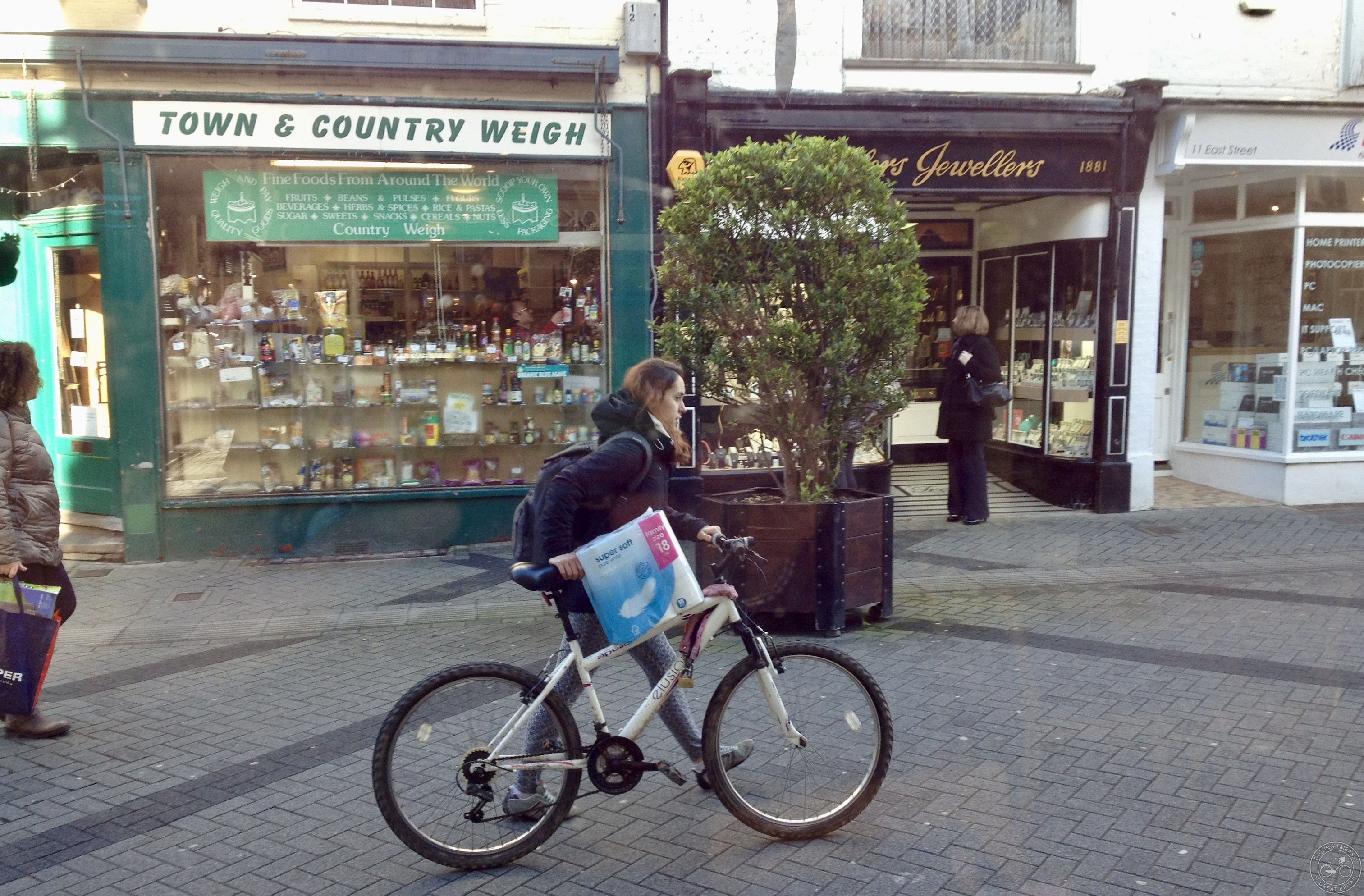
Because besides the obvious issues of road danger and safety, it is this apparent impracticality of cycling that I often see cited as a problem, or as a reason not to change the way our roads and streets are designed. 'How do you expect me to carry things?' 'How am I supposed to take the children to school?' 'How do you expect me to do the shopping?' 'Do you expect me to change in and out my clothes?'
But while these questions might seem a little ridiculous to anyone who has spent time watching Dutch people cycle around, I don't think we should blame Britons for believing these cycling fallacies, because the kinds of bikes they see on a day-to-day basis on our streets simply aren't designed for these kinds of trips. They aren't designed to carry loads, they aren't designed to be easy to use with ordinary clothes, they look uncomfortable to ride, and they certainly aren't maintenance-free.
Dutch bikes, by contrast, are a joy to ride, thanks to their upright, comfortable riding position, and they make light work of everyday tasks like carrying passengers and loads. My own Dutch bike has eliminated an enormous amount of faff and hassle from my life, so much so that I'm a little amazed when I think back to how I used to cope on my former bikes.

Comments
Graham Wilkinson
26 May, 2020 - 10:06
Permalink
A bike for people who aren't interested in cycling
Great article.
Some years ago I bought a Dutchie from the UK supplier. What a treat. It is not only practical it is also a converstion piece. I use it to go to the local shops which is a five mile round trip. No special clothing/gear needed just get on it and ride, winter or summer. Panniers and a rear rack make it ideal for the shopping trips. I originally had a front rack fitted as well but the overlapping gates on the bike tracks (to deter motor cycles) made it a tricky to negotiate them (another of the many barriers to the mass use of cycles?).
It was shipped to me from the supplier but when it arrived the forks were slightly damaged in transit. I emailed them and within a couple of days they had sent me a replacement. Great service.
I realise this type of bike doesn't appeal to everyone but for people like me who rides a bike but doesn't categorise themself as a cyclist with all the associated paraphernalia (helmets, special clothing, lightweight bikes, go-faster glasses etc) it works a treat.
Another bonus is that it doesn't appeal to the type of person who would be tempted to steal and sell on a bicycle as it is so rare it would be difficult to sell without attracting attention and as your article says it is heavy and that's another factor that makes it undesirable to a thief.
When asked what my primary form of transport is I always respond, bicycle. For that to be the case riding a bicycle has to be convenient. A Dutch style bike is very convenient for urban use and ticks all the boxes.
I hope the recent uptake of riding bicycles, due to the Corona virus lockdown, will continue as things get back to normal. Making practical bicycles more available could assist that.